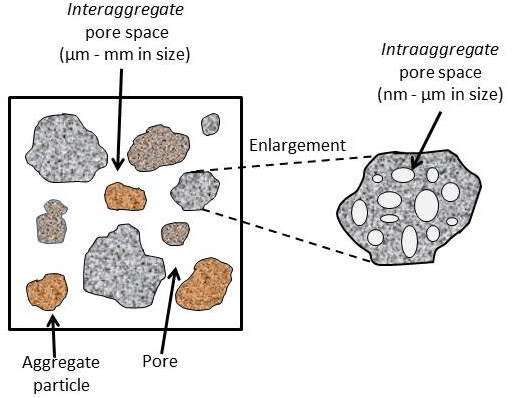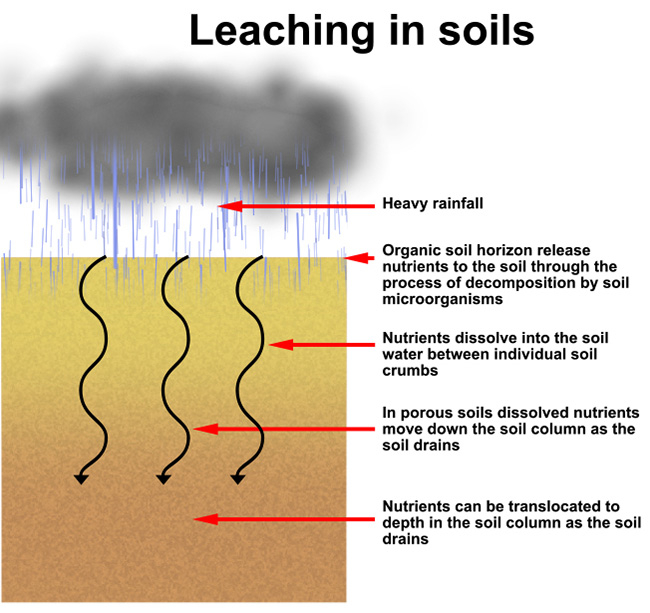קביעת תכולת הלחות בקרקע
English
Share
Overview
מקור: מעבדות של ד”ר איאן פפר וד”ר צ’ארלס גרבה – אוניברסיטת אריזונה
מחבר מפגין: בראדלי שמיץ
קרקעות מכילות בדרך כלל כמות סופית של מים, אשר יכול לבוא לידי ביטוי כמו “תוכן לחות הקרקע”. לחות זו קיימת בתוך חללי הנקבבוביות שבין אגרגטים של הקרקע (מרחב נקבוביות בין-מצטבר) ובתוך אגרגטים של הקרקע (שטח נקבוביות תוך-מצטבר)(איור 1). בדרך כלל שטח נקבוביות זה תפוס באוויר ו / או במים. אם כל הנקבוביות תפוסות באוויר, האדמה יבשה לחלוטין. אם כל הנקבוביות מלאות במים, אומרים שהאדמה רוויה.

איור 1. נקבוביות בחלל באדמה.
Principles
בסביבות טבעיות חיצוניות, מים מתווספים לאדמה באמצעות גשמים או השקיה מכוונת של צמחים. בכל מקרה, לחות הקרקע עולה ככל שיותר נקבוביות מתמלאות במים על חשבון האוויר. אם כל הנקבוביות יתמלאו במים, מים עודפים יחלפו כעת כלפי מטה (איור 2) דרך נקבוביות אדמה רציפות, עד שהגשם או ההשקיה ייפסקו. שטיפה תימשך עד שסרטי המים בתוך הנקבוביות יוחזקו על ידי מתח פני השטח של קולואידי אדמה כנגד כוח הכבידה. מצב כזה מכונה הקרקע להיות “קיבולת שדה” ביחס לחות הקרקע. אדמה בקיבולת שדה יש נקבוביות מלאות חלקית באוויר, מוקף בסרטי לחות הקרקע. בדרך כלל קרקע בקיבולת שדה היא אופטימלית לצמיחת צמחים ומיקרואורגניזמים קרקע אירוביים, שכן הן אוויר והן מים זמינים. לעומת זאת, אדמה רוויה תיצור תנאים אנאירוביים עמוסי מים שיכולים להרוג צמחים ולדכא חיידקי קרקע אירוביים, תוך גירוי חיידקים אנאירוביים.

איור 2. חומרים מזינים שטיפה באדמה.
שקול מדגם של אדמה לחה בתוך מיכל כגון. משקל האדמה ההויה מורכב ממשקל חלקיקי האדמה היבשה בתוספת משקל המים בתוך האדמה. אם מוסיפים יותר מים לאדמה, המשקל הרטוב של האדמה עולה. המשקל היבש של חלקיקי הקרקע בתוך המדגם קבוע כלומר,משקל אחד שהוא המשקל היבש. לעומת זאת, ישנם מספר אינסופי של משקולות רטובות, תלוי כמה מים מתווספים לאדמה. בגלל זה, בעת ביצוע ניסויי מעבדה עם אדמה, תכולת הלחות של הקרקע מתבטאת בדרך כלל על בסיס משקל יבש, כי המשקל היבש הוא קבוע לאורך זמן, בעוד המשקל לח או רטוב יכול להשתנות עם הזמן. כאשר מבטאים את התוצאות של ניסוי כגון התוכן התזונתי של אדמה, השימוש בבסיס המשקל היבש מספק סטנדרטיזציה של התוצאה הסופית.
Procedure
Results
Calculate the soil moisture content for each of the replicate samples using the following equation:
% moisture content (MC) = 
(dry wt. basis)
Example Calculations:
M = 102 g
D = 90 g
∴ % MC = 
MC = 13.3%
With the addition of 5 g of water, new M = 107 and D still equals 90
∴ % MC = 
New MC = 18.9%
Applications and Summary
Knowledge of the moisture content of a soil on a dry weight basis is useful in a number of ways. For example, if the experiments are conducted with soil that should be amended with a known concentration of ammonium fertilizer (for example 50 μg/g), then the moisture content on a dry weight basis must be determined. If the calculation was completed on a wet weight basis, the amount of fertilizer to be added would depend on the moisture content (and therefore the moist weight) of the soil sample. Likewise, if potted plants are considered, the moisture content must be known in order to make sure that the soil isn’t too dry (not enough moisture for plant growth) or too wet (waterlogged and anaerobic). In a field situation, knowledge of the soil moisture content can prevent excess irrigation and leaching of soil nutrients.
Transcript
The amount of water held in soil is an important component of biological and ecological processes, and is used in applications such as farming, erosion prevention, flood control, and drought prediction.
Soils typically contain a finite amount of water, which can be expressed as the soil moisture content. Moisture exists in soil within the pore spaces between soil aggregates, called inter-aggregate pore space, and within pores in the soil aggregates themselves, called intra-aggregate pore space. If the pore space is occupied entirely by air, the soil is completely dry. If all of the pores are filled with water, the soil is saturated.
The measurement of the amount of water held within the soil, or the soil moisture content, is essential to the understanding of soil characteristics and the types of plants and microorganisms that reside in it.
This video will introduce the basics of soil moisture content, and demonstrate the procedure for determining moisture content in the laboratory.
In outdoor environments, water is added to soil naturally through rainfall or deliberately with the irrigation of plants. As the pores in the soil become filled with water at the expense of air, the soil moisture increases. When all of the pores are filled with water, the soil is saturated. If the soil at the surface is saturated, excess water will leach downward through pores into deeper soil. Leaching continues until there is not enough water to saturate all of the pore space. At this point pores contain some air and thin films of moisture. The water films within the pores are held by the surface tension of soil colloids, thus water stops leaching.
After leaching stops, and excess water has drained from the soil, the soil is described as being at field capacity. Soil at field capacity has pores that are partially filled with air, surrounded by films of moisture. Soil at field capacity is optimal for plant growth and aerobic soil microorganisms, since both air and water are available. In contrast, saturated soil, where all pores are filled with water, will create an anaerobic environment that can kill plants and suppress aerobic soil microbes.
The mass of moist soil consists of the mass of the dry soil particles, plus the mass of the water within the soil. The dry mass of the soil particles is fixed, whereas the amount of water within moist soil can vary. Therefore, moisture content is calculated on a dry basis, rather than a total mass basis, to ensure consistency. The moisture content of soil is described as the ratio of the mass of water held in the soil to the dry soil. The mass of water is determined by the difference before and after drying the soil.
The following experiment will demonstrate how to measure soil moisture content in the laboratory using these principles.
To begin, collect soil samples and transfer them into the laboratory. Samples of soil can be collected in the field using a soil auger, or a trowel. Use of a soil auger allows for the soil to be sampled to specific depths. Transfer them into the laboratory. Weigh two aluminum dishes, and accurately record the weight of each dish. Aliquot approximately 20 g of the moist soil into each aluminum dish, then reweigh the dish. Subtract the weight of the empty dish from the full dish to acquire the moist soil weight.
Next, dry the soil overnight in an oven set to 105 °C. On the next day, carefully remove the soil samples from the oven using tongs. Place the soil samples on the bench top to cool. When the dry soil samples are cool, reweigh them and record the total weight. Subtract the weight of the aluminum dish, and record the dry soil weight.
Calculate the moisture content of the soil by subtracting the weight of the dry soil from the weight of the moist soil, and then dividing by the weight of the dry soil.
Although the measurement is simple, it is important to determine soil moisture content in order to better understand soil characteristics.
Soil moisture content plays a large roll in environmental concerns, especially when considering soil runoff that may contain fertilizers and pesticides. In this example, soil runoff was analyzed using a simulated rainfall study in order to determine the retention of a compound in moist soil.
Soil, containing urea, was packed into soil boxes and assembled under a rainfall simulator. Soil runoff was collected, and the concentration of urea in the runoff water calculated. The amount of urea in the soil runoff was higher for soils that had higher moisture content, indicating that urea is better absorbed in drier soil, than in moist.
The fate of chemicals in soil can also be analyzed by direct pore water sampling, using a lysimeter, as shown in this example. In this experiment, lysimeters, or long metal tubing, were installed in soil with turf grass to analyze pore water in vegetative soil.
The pore water sampler was then installed, and water pumped from the lysimeter after applying chemicals to the soil. The collected water was then analyzed, and the concentration of applied chemicals correlated to soil depth and moisture content.
The results demonstrated that the concentration of the herbicide monosodium methyl arsenate, or MSMA, was the highest in the top 2 cm of soil.
You’ve just watched JoVE’s introduction to soil moisture content. You should now understand how to accurately measure soil moisture content in the laboratory. Thanks for watching!




